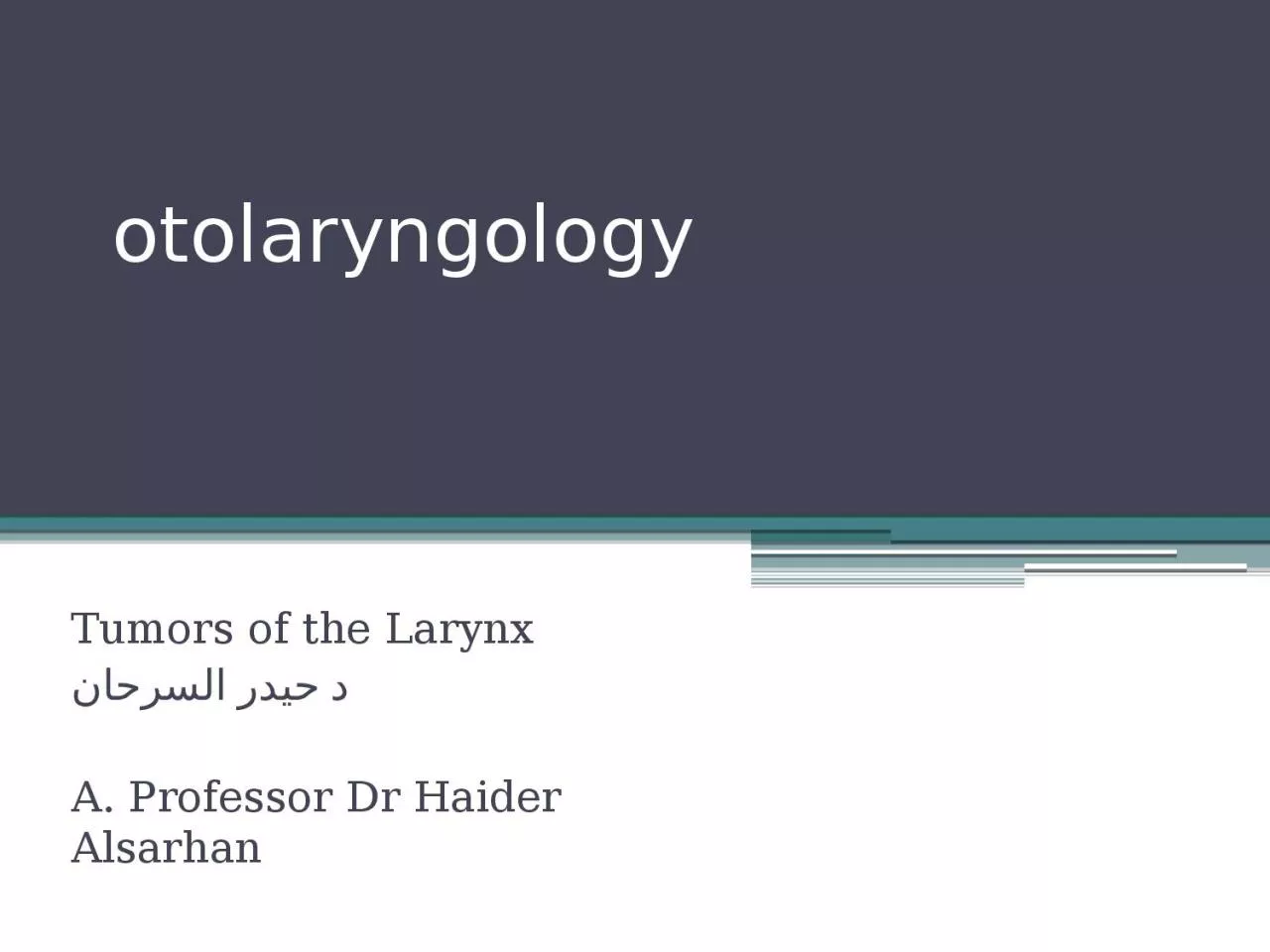

د حيدر السرحان A Professor Dr Haider Alsarhan Benign tumors hemangioma chondroma Leomyoma Rhabdomyoma Paraganglioma Papilloma Malignant tumors squamous cell carcinoma 85 ID: 929549
Download Presentation The PPT/PDF document "otolaryngology Tumors of the Larynx" is the property of its rightful owner. Permission is granted to download and print the materials on this web site for personal, non-commercial use only, and to display it on your personal computer provided you do not modify the materials and that you retain all copyright notices contained in the materials. By downloading content from our website, you accept the terms of this agreement.
Slide1
otolaryngology
Tumors of the Larynx
د
حيدر
السرحان
A. Professor Dr
Haider
Alsarhan
Slide2Benign tumors:
hemangioma
chondroma
Leomyoma
Rhabdomyoma
Paraganglioma
Papilloma
Slide3Malignant tumors:
squamous
cell carcinoma 85%
undifferentiated carcinoma 5%
verrucous
Carcinoma 3%
carcinoma
insitu
3%
sarcoma 2%
Adenocarcinoma
0.5%
others(
miscellaneous:adenoid
cystic carcinoma , Lymphoma ,..) 1.5%
Slide4Surgical Anatomy:
The larynx is divided into three regions which each include a number of sites:
1.
Supraglottis
. This comprises the larynx superior to the apex of the ventricle. It includes the ventricle, vestibular folds, arytenoids,
aryepiglottic
folds and the epiglottis.
2.
Glottis
. This comprises the vocal cords and the anterior and posterior
commissures
.
3.
Subglottis
. This extends from the inferior border of the glottis to the lower border of the
cricoid
cartilage.
Slide5Clinical Feature :
Hoarseness
is the commonest and often the only presenting symptom
Dyspnoea
and
stridor
are late symptoms and almost invariably indicate an advanced
tumour
.
Pain
is an uncommon symptom but is most typical in
supraglotic
tumours
. Patients with a cancer in this site may complain of a
unilateral sore throat
. There maybe
referred
otalgia
.
Dysphagia
indicates invasion of the pharynx.
Swelling of the neck
may be due to direct penetration of the
tumour
outside the larynx or to lymph node metastases.
Cough and irritation
of the throat are occasional symptoms. The general symptoms of
norexia
,
cachexia
and fetor
are usually
associat
Slide6INVESTIGATION:
Chest X Ray
Protein level
MRI & CT Scan
DL and Biopsy
panendoscopy
including
bronchoscopy
Slide7Staging:
T (tumor mass)
Supraglottis
.
T1
Tumour
limited to one
subsite
of the
supraglottis
.
T2 Invasion of more than one
subsite
of the
supraglottis
or glottis
T3 Confined to larynx with a fixed vocal cord or invades the
postcricoid
area,
preepiglottic
tissues, base of tongue.
T4 Extends beyond the larynx.
Slide8Glottis
.
T1(a)
Tumour
limited to one vocal cord.
T1(b) Involves both vocal cords.
T2
Tumour
extends to
supraglottis
and/or
subglottis
, or impaired cord mobility.
T3 Confined to the larynx with a fixed vocal cord.
T4 Extends beyond the larynx.
Slide9Subglottis
.
T1
Tumour
limited to
subglottis
.
T2 Extends to vocal cords with normal or impaired mobility.
T3 Vocal cord fixed.
T4 Extends beyond the larynx
Slide10N (lymph node metastasis)
N0 no lymph node metastasis
N1
Iipsilateral
single LN less than 3 cm in size
N2
A
Ipsilateral
single
LN 3-6 cm in size
B
Ipsilateral
multiple less than 6 cm in size
C
Cotralateral
OR bilateral LN less than 6 cm size
N3 LN more than 6 cm size
M (distant metastasis)
M 0 no distant metastasis
M1 distant metastasis
Slide11Treatment
1. Curative treatment may involve radiotherapy, surgery or a combination of these two modalities.
A/ small tumors are treated by radical Radiotherapy in the first instance, with surgery reserved for recurrence. Preservation laryngeal surgery (partial
Laryngectomy
) is also an option with small tumors.
B/Larger tumors tend to be treated with primary surgery, usually with postoperative radiotherapy.
2. Palliative treatment includes pain relief,
tracheostomy
, insertion of a
percutaneous
gastrostomy
, palliative radiotherapy, chemotherapy and occasionally surgery.
Slide12General roles of treatment :
T1 N0 M0 Radiotherapy
T2 N0 M0 partial
laryngectomy
T3 N0 M0 Total
laryngectomy
T3
Nx
M0 Total
laryngectomy
with radical neck dissection
T4 palliative
M1 Palliative
Slide13THANKS